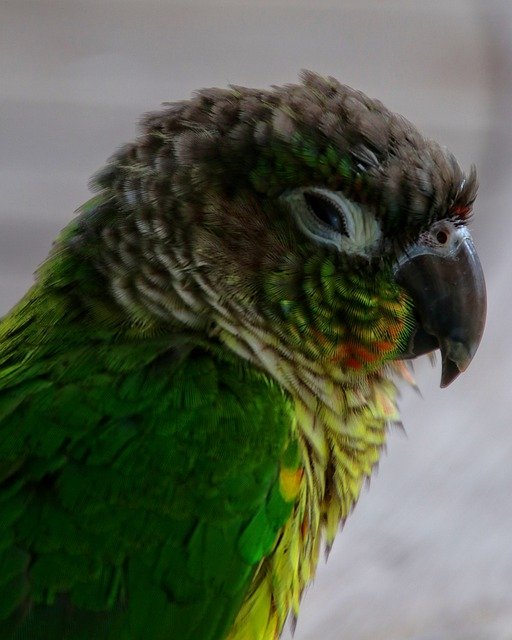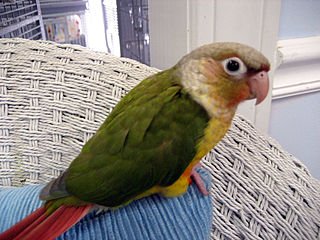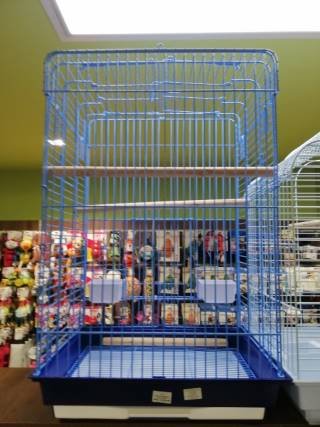In addition to their affectionate and playful personalities, the Green Cheek Conure can also be found in a variety of stunning colors achieved through selective breeding and gene mutation. Green Cheek Conures naturally have bright green feathers on their cheeks and wings, gray feathers on their chest, and red tail feathers.
When looking to bring home a new Green Cheek Conure, you will soon find that they come in a seemingly endless array of colors. Research and selective breeding have resulted in a variety of color mutations each with its own distinct color palettes and patterns. Each mutation has its own set of unique physical characteristics and slight variations in temperament and personality.
American Dilute
One of the many sought-after color mutations of the Green Cheek Conure is the American Dilute mutation which results in a more subdued appearance of their natural color palette and a soft-cream plumage. The American Dilute is a recessive gene mutation that reduces the amount of melanin present in the feather pigmentation and gives a diluted appearance compared to their original variations.
This mutation is rarely bred and those interested in the American Dilute Conures can expect a higher price of up to $600. While the American Dilute Conure color mutation is rare to find, they still share the same sweet demeanor and affectionate personalities as their non-mutated variations.
Suncheek
Another common mutation of the Green Cheek Conure is the Suncheek gene mutation. In contrast to the original Green Cheek Conure which is primarily green with a small amount of yellow and red, the Suncheek mutation’s feather pigmentation is nearly all vibrant yellow reads. Most Suncheek Conures will have a primarily yellow body, red wing and tail feathers, and light-colored feathers on its head. This mutation is less common to find and will cost anywhere between $300-$800 depending on location and breeder. These birds have a personality that is just as bright as their plumage. They will surely light up any room they are in with their vibrant coloring and peppy personalities.
The Suncheek mutation is known for being more energetic than its other Conure variations. To help keep these birds happy and healthy, their owners need to make sure that they are spending plenty of quality time together and giving their birds lots of engaging toys and cage accessories. The mutation was developed in the United States and later brought into Canada.
Pineapple Conure
The Pineapple mutation of the Green Cheek Conure expresses a combination of both the Yellow Sided and Cinnamon mutations. The Pineapple mutation Conures have the vibrant yellow pigments from their Yellow Sided lineage and the lime green, beige head, and maroon-brown eyes of their Cinnamon genetics.

The amount and hue of red pigment present on their chest depends on the vibrancy and color combination of their Yellow Sided Conure mutation parentage. Pineapple Green Cheek Conures are one of the fewer color mutations and will on average have an asking price of $300-$500 dollars.
Yellow-sided

Yellow Sided mutation of the Green Cheek Conure results in a distinct spread of yellow and red feather pigmentation, green wings, and colored beaks and feet. The vividness and intensity of the red and yellow hues can be enhanced with selective breeding and result in a range of colors from vibrant yellow to maroon.
This mutation is more common and can be found anywhere between $200-$250 depending on the breeder and color. In addition to their vibrant feathers, the Yellow-Sided Conures are known for their energetic and outgoing personality. If you find yourself bringing home a Yellow-Sided Conure, don’t be surprised if you see your new companion dancing in their cage or happily chirping to themselves.
Turquoise

Photo Credit: Toumoto CC BY-SA (http://creativecommons.org/licenses/by-sa/3.0/)
One of the rarest and most sought-after variations of the Green Cheek Conure is the Turquoise mutation. The Turquoise mutation is a recessive color mutation that suppresses the expression of red and yellow pigments. As the name implies, this mutation of the Green Cheek Conure has a striking and distinct blueish-green plumage. Additionally, they have radiant turquoise feathers on their cheeks, gray tail feathers, and deep blue-colored beaks and feet.
Being a rare and highly desired mutation, you can expect to pay more when looking for a Turquoise Green Cheek Conure. The price can range between $450-$750 depending on the region and breeder. Owners of the Turquoise Conure should know that they can be a bit standoffish when first meeting new people, but like other Conures, they warm up quickly and have affectionate and sweet demeanors.
Mint
Mint is a visual recessive of Turquoise and American Dilute. It has a pastel color plumage with a silver head and platinum color tail, dark eyes, feet, and beak.
Cinnamon
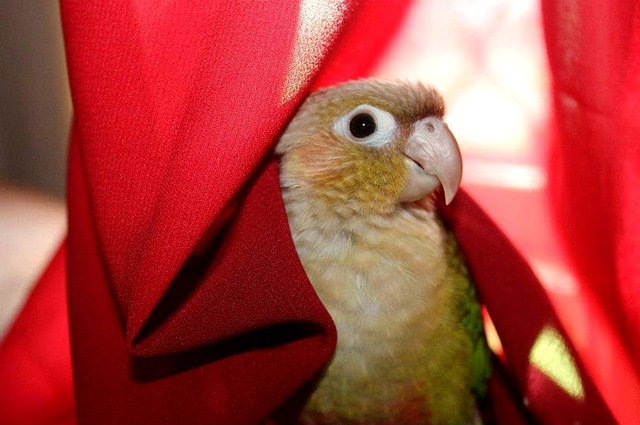
Cinnamon is a sex-linked mutation that stops the oxidation of melanin. The conversion of brown pigment into black is inhibited. That’s why they cannot produce any shade of black or gray color. The is plumage light green. The tale is lighter maroon. Eyes are red-brown, which makes breeders very proud. The eye color is getting darker as they age. All Cinnamons have them, but it’s not a distinguishing trait.
Original Green Cheek Conure facts
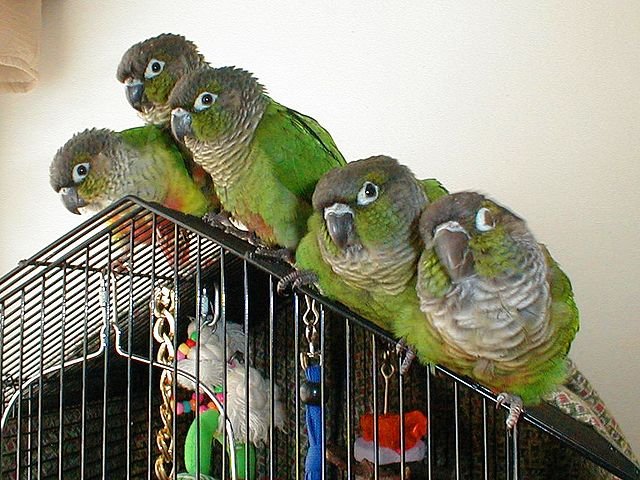
Known as Molina’s conure, Green Cheek Conures are native to forests of South America. Northwestern Argentina, Western Paraguay, Northeastern Bolivia, and Brazil, are home to this unique species.
Their natural habitat is in woods, on altitudes as high as 3000 meters. They tend to live around in flocks, in the treetops. Groups can have more than 20 members if there’s enough food to support them.
With 10 inches in length and 5.5 inches in the wingspan, they are considered small. They are also monomorphic, meaning there is no physical difference between males and females. Juvenile ones have duller plumage and are less maroonish on the chest than the more mature birds.
As the name suggests, their cheeks are green. They have white rings around their eyes. The Green Cheek Conure bill is gray in color. This look is considered to be a normal mutation.
It is considered a New World Parrot. The name comes from the fact that these species have become known to the world from Columbus’s journal, as they are native to the USA and Caribbean.
How much does the Green Cheek Conure cost?
Before making a decision, make sure to consider the costs. Green Cheek Conures typically cost somewhere between $250 and $500. However, this is the price of the bird only. The additional expenses include cage, equipment, food, and medical care. Here is a brief overview, the example prices of some of your Conure’s necessities.
Each of the genetic mutations adds unique qualities to an already unique bird. With so many variations available, it’s important to research each mutation and find the one that best suits you and matches the qualities you are looking for in your new pet bird. If you are unsure of where to start, seek out reputable breeders in your area to get more information about finding your ideal pet bird.
